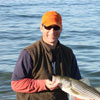Beat the Heat
By Tom Keer
Jul 31, 2014
I spoke with my friend Dave Dayton last week and he was all jacked up. He and his son fished for two mornings at Honey Lake Plantation in Northern Florida, right on the Florida/Georgia Line (sorry, I couldn’t resist). So how was the fishing, Dave?
I spoke with my friend Dave Dayton last week and he was all jacked up. He and his son fished for two mornings at Honey Lake Plantation in Northern Florida, right on the Florida/Georgia Line (sorry, I couldn’t resist). So how was the fishing, Dave?
“Epic,” he said. “We had non-stop catching for three hours, with largemouth bass, tiger bass, and bream on the feed. We lost count of the numbers, but it was a fish-per-cast easily, and that good fishing was spread across a three hour period during both days. It makes up for those days when there is more fishing than catching, and the conditions were perfect, particularly for families.”
Many columns, and I’ve written some too, always talk about the summer blues. In them we talk about schools of fish bailing from the shallows ‘cause they’re too warm. Anglers need to focus their fishing around early mornings when the temperatures have cooled down, they need to fish at night, or they need to get down a thermocline or two. Once we find deeper water or colder pockets we will find and catch fish. That is true if we’re targeting cold water fish like trout or striped bass or fish that prefer cooler temps. But as Dave pointed out, some fish like it hot.
Right now my striper fishing follows that same rule of thumb. It’s hot so the bass are in the rips where there are tremendous current exchanges. They are also at the 100 foot mark which is perfect for vertical jigging. They’re also in the rocks and ledges found around many coastlines and inshore islands. I’ll tell you where they’re not, and that is in the estuaries, saltponds or flats. What’s there instead? Bluefish, what else?!
Bluefish, those hard-hitting, hard-fighting fish have replaced the striped bass in those waters because the blues prefer the warm temperatures. There are a number of different sizes to catch, from snappers (8-10 inches), cocktails (1-2 feet long), and adult blues (5-10 pound class). The choppers will be in later when the water is good and warm. They’re in the 10-15 pound or bigger class.
And around the Gulf Stream, other fish like warm water. Like tuna. Green bonito. Spanish macs. Skipjack. False albacore. The same idea cuts across into the fresh, and that’s where you’ll find great warm water conditions for largemouth bass, catfish, green sunfish, and spotted bass. So when the water temps turn you don’t have to get up early or go deep to catch fish. Just target a different species.
“Epic,” he said. “We had non-stop catching for three hours, with largemouth bass, tiger bass, and bream on the feed. We lost count of the numbers, but it was a fish-per-cast easily, and that good fishing was spread across a three hour period during both days. It makes up for those days when there is more fishing than catching, and the conditions were perfect, particularly for families.”
Many columns, and I’ve written some too, always talk about the summer blues. In them we talk about schools of fish bailing from the shallows ‘cause they’re too warm. Anglers need to focus their fishing around early mornings when the temperatures have cooled down, they need to fish at night, or they need to get down a thermocline or two. Once we find deeper water or colder pockets we will find and catch fish. That is true if we’re targeting cold water fish like trout or striped bass or fish that prefer cooler temps. But as Dave pointed out, some fish like it hot.
Right now my striper fishing follows that same rule of thumb. It’s hot so the bass are in the rips where there are tremendous current exchanges. They are also at the 100 foot mark which is perfect for vertical jigging. They’re also in the rocks and ledges found around many coastlines and inshore islands. I’ll tell you where they’re not, and that is in the estuaries, saltponds or flats. What’s there instead? Bluefish, what else?!
Bluefish, those hard-hitting, hard-fighting fish have replaced the striped bass in those waters because the blues prefer the warm temperatures. There are a number of different sizes to catch, from snappers (8-10 inches), cocktails (1-2 feet long), and adult blues (5-10 pound class). The choppers will be in later when the water is good and warm. They’re in the 10-15 pound or bigger class.
And around the Gulf Stream, other fish like warm water. Like tuna. Green bonito. Spanish macs. Skipjack. False albacore. The same idea cuts across into the fresh, and that’s where you’ll find great warm water conditions for largemouth bass, catfish, green sunfish, and spotted bass. So when the water temps turn you don’t have to get up early or go deep to catch fish. Just target a different species.
Popular Posts









